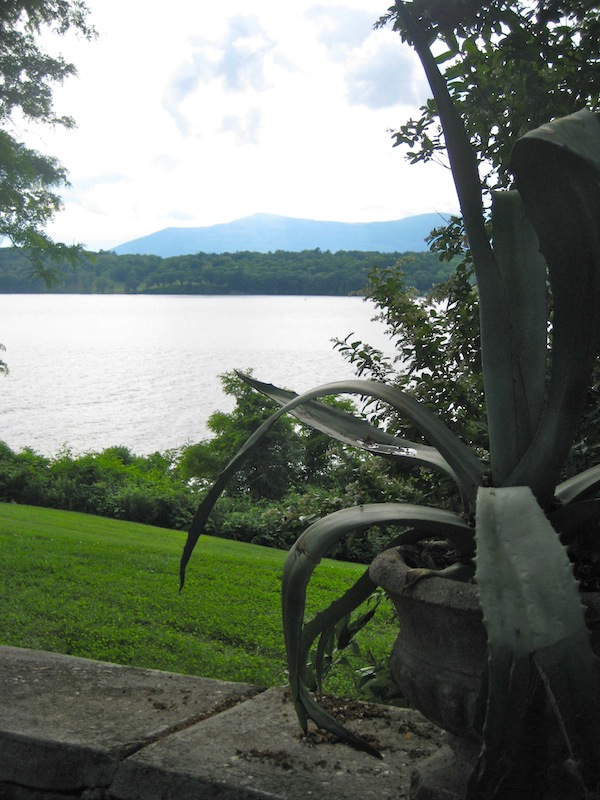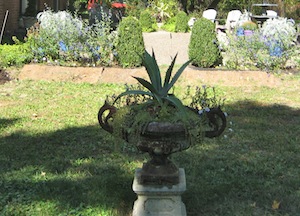An agave that was no ordinary agave: The Century Plant at Montgomery Place



Agave plants entered my consciousness when I first moved up to the Hudson Valley, where they can be found gracing the porches and terraces of several notable hudson river estates including ClermontCentury Plant on the terrace at Clermont and Montgomery Place.Agave on the porch at Montgomery Place Native to Central America, these succulents are generally found in urns and pots and moved inside during the winter months. Inspired, I obtained a couple for my own home. Their texture and color adds interest and a touch of exoticism to my summer garden.Agave at Schoolfield The off-season however, is a less pleasant period for both the plants and myself. Their spiny leaves render repotting a far from joyous activity. Under my clumsy efforts, the threat of impaling a palm on one becomes a very real possibility. Aside from their spiky ends, their thick, flat, broad leaves tend to leave very little opportunity for water (when I remember to water them) to go into their pots, as opposed to running down the leaves and spilling onto the floor. The drawbacks seriously compete the benefits and I have sometimes debated either giving them away or giving them an eskimo grandparent send-off and leaving them outside to freeze to death (setting them adrift on an iceflow on the Hudson being a little too ambitious for me). Recently however, Ray Armater, the Director of Montgomery Place, showed me a vintage photograph that demonstrated not all agave are not created equal, and on rare occasions, magic can happen.Century Plant in bloom at Montgomery Place, 1873During the summer of 1873, announcements in local newspapers in the area invited the public to a very unique, rare horticultural event at Montgomery Place (then still a private estate). The Century Plant (Agave Americana) at Montgomery Place would be blooming imminently. The name “Century Plant” is a bit of a misnomer, as these plants usually have a life span of thirty or forty years max. on the other hand, that probably equates to forever in plant years. Semantics aside, Century plants operate this way, more or less. They sit around innocently for several decades, looking like any other agave. One day, just when you think they are never going to do anything with their lives, they begin to show signs of flowering. And boy what a flowering it is! They send a stalk shooting up to 25 feet in the air over the course of several days, from which yellow flowers emerge. The spectacular display is of a relatively short duration, and when the blooms go, so does the plant.
Tradition says that Montgomery Place’s Century plant was there while Janet Livingston Montgomery, the estate’s builder was still alive. After her death it passed to the next chatelaine of the estate, Louise D'Avezac Livingston, and then onto to her daughter Coralie Barton after her demise. Cora Barton was very active in developing the romantic gardens at Montgomery Place, and was very interested in the Century Plant. Sadly, Mrs. Barton died a few months before the plant bloomed. Before her death, Cora Barton had asked Mr. Alexander Gilson, the African-American head gardener at Montgomery Place, who had worked alongside her for decades in the creation of these elaborate pleasure grounds, to open the estate so that all could observe this horticultural wonder.
Aside from the fact that even in black and white, the Century Plant at Montgomery Place is an impressive image, as well as the possibility that it outlived three successive owners, for me part of its appeal is how it connects Montgomery Place, built by Mrs. Montgomery, with Clermont the home of her mother Margaret Beekman Livingston. Although the Century Plant dies after blooming, it produces suckers from which new plants emerge. No one is sure whether the Century Plant at Montgomery Place was descended from a plant originally at Clermont, or the ones found at Clermont today are offshoots of an original from Montgomery Place, but either scenario is entirely plausible. I have been told the plants in the urns at Clermont are root-bound and sadly will probably never bloom. I also learned the agave currently at Montgomery Place are not actually descended from the century plant in the picture but are another variety entirely, with less spiky leaves. As for mine, I don’t really know if either of my agave are century plants, being really bad at distinguishing these things (although one of plants does resemble pictures I have seen online). The possibility that one could potentially be however, means I will probably let them stick around for next twenty or thirty years, to see what happens.



